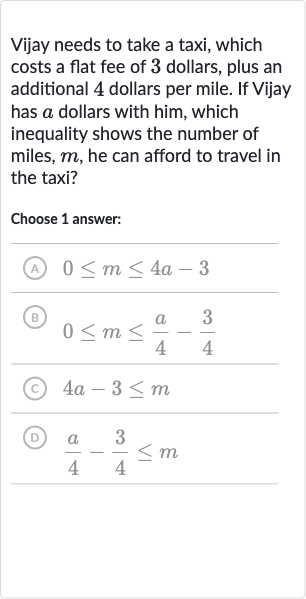AI tutor
Full solution
Q. Vijay needs to take a taxi, which costs a flat fee of dollars, plus an additional dollars per mile. If Vijay has dollars with him, which inequality shows the number of miles, , he can afford to travel in the taxi?Choose answer:(A) (B) (C) (D)
- Calculate Total Cost: The total cost of the taxi ride for miles is the sum of the flat fee and the cost per mile. The flat fee is dollars and the cost per mile is dollars.
- Represent Total Cost: The total cost for miles can be represented by the equation: .
- Substitute Given Values: Substitute the given values into the equation: Total Cost .
- Set Up Inequality: Vijay can afford to take the taxi as long as the total cost is less than or equal to the amount of money he has, which is dollars. So, we have the inequality: .
- Isolate Variable: To find the inequality for , we need to isolate on one side. Subtract from both sides of the inequality: .
- Solve for m: Now, divide both sides of the inequality by to solve for : .
- Rewrite Inequality: The inequality can be rewritten as , since the number of miles cannot be negative.
- Simplify Inequality: The inequality can be further simplified by dividing the numerator and the denominator by : .
More problems from Write two-variable inequalities: word problems
QuestionGet tutor help
QuestionGet tutor help
QuestionGet tutor help
QuestionGet tutor help
QuestionGet tutor help
QuestionGet tutor help
QuestionGet tutor help
QuestionGet tutor help

